
KIAS has issued an academic journal, "KIAS Bulletin," to support the publication of research results. In addition, we publish the booklet series "Kyoto Series of Islamic Area Studies" to make it easier to announce manuscripts with a high rate of completion and high volume.
About the dissemination of research results, we do not assume that the language is limited to Japanese or that the authors are also Japanese, in order to enhance its global appeal. We are also planning to publish booklets in various other fields such as economics, thought , and literature.
<Backlist of Kyoto Series of Islamic Area Studies>
No.1 Sufi Pilgrims from Central Asia and India at Jerusalem
No.2 The Global Financial Crisis: Some Suggestions for Reform of the Global Financial Architecture in the Light of Islamic Finance
No.3 What's Really Going on in Afghanistan? (In Japanese)
No.4 Catalog for the Printed Books of the School of Ibn 'Arab? Collected in Japanese Libraries (In Japanese)
No.5 Towards Multilateral Elucidation of Islamic Trends in South Asia: History, Thought, Literature, and Politics (In Japanese)
No.6 Best Practices in Socially Responsible Finance: Lessons for the Islamic Financial Industry from Leading Socially Responsible Financial Institutions in the UK
No.7 A Bio-bibliographical Introduction to the Intellectual History of the Ottoman Period (In Japanese)
No.8 South Asia and Islam:"Kagaya Hiroshi" Collection 1 (In Japanese)
No.9 Islamic Finance for Agricultural Development in Malaysia
No.10 Politics and Culture in South Asia:"Kagaya Hiroshi" Collection 2 (In Japanese)
No.11 Contesting Authenticity: Interpreting and Observing Islam in the Center From the Classical to the Modern Period
No.12 Society and Thought of Modern Iran:"Kagaya Hiroshi" Collection 3 (In Japanese)
About the dissemination of research results, we do not assume that the language is limited to Japanese or that the authors are also Japanese, in order to enhance its global appeal. We are also planning to publish booklets in various other fields such as economics, thought , and literature.
<Backlist of Kyoto Series of Islamic Area Studies>
No.1 Sufi Pilgrims from Central Asia and India at Jerusalem
No.2 The Global Financial Crisis: Some Suggestions for Reform of the Global Financial Architecture in the Light of Islamic Finance
No.3 What's Really Going on in Afghanistan? (In Japanese)
No.4 Catalog for the Printed Books of the School of Ibn 'Arab? Collected in Japanese Libraries (In Japanese)
No.5 Towards Multilateral Elucidation of Islamic Trends in South Asia: History, Thought, Literature, and Politics (In Japanese)
No.6 Best Practices in Socially Responsible Finance: Lessons for the Islamic Financial Industry from Leading Socially Responsible Financial Institutions in the UK
No.7 A Bio-bibliographical Introduction to the Intellectual History of the Ottoman Period (In Japanese)
No.8 South Asia and Islam:"Kagaya Hiroshi" Collection 1 (In Japanese)
No.9 Islamic Finance for Agricultural Development in Malaysia
No.10 Politics and Culture in South Asia:"Kagaya Hiroshi" Collection 2 (In Japanese)
No.11 Contesting Authenticity: Interpreting and Observing Islam in the Center From the Classical to the Modern Period
No.12 Society and Thought of Modern Iran:"Kagaya Hiroshi" Collection 3 (In Japanese)

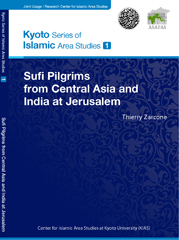
Sufi Pilgrims from Central Asia and India at Jerusalem
Thierry Zarcone
(2009/March, xvii + 168p.)
| INTRODUCTION | 1 | |
| Chapter One SUFI LODGES, HOSPICES, AND PILGRIMS | 11 | |
| Pilgrims, Sufis, and Hospices | 13 | |
| A Network of Sufi Lodges? | 24 | |
| Chapter Two CENTRAL ASIAN AND INDIAN SUFI ORDERS ON THE PILGRIMAGE ROUTES | 26 | |
| The Domination of the Naqshbandiyya over the Hajj Routes | 28 | |
| Regarding the Qalandars and the Qalandar Hospices (Qalandarkhanas) | 32 | |
| Chapter Three CENTRAL ASIAN AND INDIAN LODGES OF JERUSALEM | 43 | |
| The Uzbek Lodge, al-Zawiya al-Uzbakiyya | 43 | |
| The Afghan Lodge, al-Zawiya al-Afghaniyya | 92 | |
| The Indian Lodge, al-Zawiya al-Hunud | 98 | |
| CONCLUSION | 108 | |
| APPENDIX | 110 | |
| Visitors to the Zawiya al-Uzbakiyya for the following years: 1911.1915 / 1924.1928 / 1938.1959 | 110 | |
| BIBLIOGRAPHY | 148 | |
| INDEX | 160 |
Excerpt from the introduction
Since the beginning of the pilgrimage to Mecca, pilgrims used many routes to travel from Western and Eastern Turkestan to the Hijaz. One such route ran from Samarkand and Bukhara across Afghanistan, through Mazar-i Sharif and Kabul, to Bombay in British India, and thence by boat to Jidda and Yambu. Another route usually followed by the Muslims of Russia, Tataristan, and Caucasia, in addition to some Central Asians, traversed through southern Russia, reaching Istanbul via boat across the Black Sea, and thence to Syria or Egypt and eventually the Hijaz. Once in Cairo or Damascus, the pilgrims would join the official Mecca caravans - mahmal sh?m? from Damascus or mahmal misr? from Cairo. A third, more convenient route proceeded through Iran and Baghdad, while the fourth route, mainly preferred by the Eastern Turkestani and the Muslims of the Ferghana Valley, ran across the Himalayas and Kashmir to Bombay in British India and from there to Basra or Jidda. The Central Asians were not the only pilgrims to travel to the Hijaz through India; the same route was also taken, though rarely, by the Tatars from the Volga area who chose to embark on this long detour eastwards in order to visit Bukhara, which was so fascinating to their eyes. From Bombay, these Central Asian pilgrims joined the bulk of the Indian pilgrims, who constituted the majority of the visitors to the holy cities of Islam. In the nineteenth century, Bombay also happened to be one of the ports where Chinese Muslims journeying from Hong Kong would join the Indian pilgrims. ...

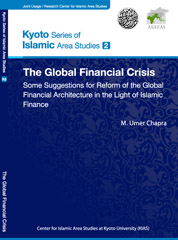
The Global Financial Crisis: Some Suggestions for Reform of the Global Financial Architecture in the Light of Islamic Finance
M. Umer Chapra
(2009/June, ix + 51p.)
| Chapter One: PRIMARY CAUSE OF THE CRISES | 1 | |
| The Subprime Mortgage Crisis | 2 | |
| Making a Humane Arrangement for Subprime Borrowers | 7 | |
| The Prevailing Imbalances in the U.S. Economy | 9 | |
| Chapter Two: THE ISLAMIC FINANCIAL SYSTEM | 13 | |
| Injecting Another Dimension of Justice | 20 | |
| Islamic Finance in Practice | 25 | |
| Chapter Three: IS THIS OF ANY RELEVANCE TO THE CONVENTIONAL SYSTEM? | 26 | |
| REFERENCES | 28 | |
| Appendix I: Author’s Core Publications | 33 | |
| Appendix II: Author’s Other Publications | 37 |
Abstract
The book tries to determine the primary cause or causes of the financial crises that have plagued almost every country around the world over the last three decades. Of particular significance is the current subprime mortgage crisis in the United States which has had worldwide spillover effects. It argues that one of the major causes of these crises is the absence of risk-sharing, which dilutes market discipline in the financial system and leads to excessive lending, high leverage, speculation, and unsustainable rise in asset prices. Unwinding later on gives rise to a vicious cycle of selling that feeds on itself and leads to a steep decline in asset prices followed by financial crisis and economic slowdown. Risk-sharing along with the availability of credit for primarily the purchase of real goods and services that Islamic finance aims at introducing, can help inject greater discipline into the system and, thereby, substantially reduce financial instability. Since the introduction of greater discipline into the financial system may deprive the subprime borrowers of credit, the book also discusses the need for finding ways of satisfying their genuine credit needs.

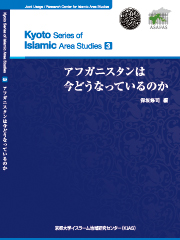
What's Really Going on in Afghanistan? (In Japanese)
Edited by HOSAKA Shuji
(2010/March, xix + 155p.)
| INTRODUCTION | v | ||
| About the Authors | x | ||
| Chronology of Events relating to Afghanistan | xiii | ||
| Maps and Charts | xiv | ||
| Afghanistan-Pakistan Basic Data | xv | ||
| Part 1: Ground Zero | |||
| I. Background of the Appearance of Taliban and the Leader Mullah Umar | (TAKAHASHI Hiroshi) | 2 | |
| II. Abdullah Azzam and Arab Mujahideen | (HIGUCHI Seiji) | 28 | |
| Part II: From the Crisis Scene | |||
| III. Afghanistan Today | (TANAKA Koichiro) | 48 | |
| IV. Complicated Situation in Pakistan | (INOUE Aeka) | 64 | |
| Part 3: Terrorism or Jihad | |||
| V. US War on Terrorism and Afghanistan | (MIYASAKA Naofumi) | 78 | |
| VI. Current Situation of al-Qaeda in Afghanistan | (HOSAKA Shuji) | 92 | |
| Bibliography related to al-Qaeda | 116 | ||
| Bibliography related to Taliban | 136 |
Almost 10 years have passed since the September 11 attacks and the United States' response to them; that is, her invasion of Afghanistan to depose the Taliban, who were harboring al-Qaeda.
What is going on in Afghanistan? What is the current status of the Taliban? And of al-Qaeda? One of the key element s in re-evaluating the significance of the 9/11 attacks from a fresh perspective would be to review them in the light of the present situation in Afghanistan, which has been the epicenter of a series of international events.
The main contents of this booklet are a record of the workshop held at Kyoto University on October 18, 2008, entitled "What is going on in Afghanistan?", which discussed various topics such as Afghanistan before 9/11, the origins of the Taliban, Arab Mujahidin crowded around Afghanistan, Afghanistan and Pakistan relations since 9/11, the status of al-Qaeda, and US security policies towards "terrorists." In addition, this booklet includes the latest information about these topics.

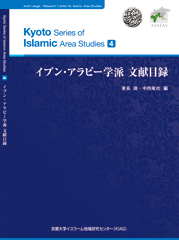
Catalog for the Printed Books of the School of Ibn 'Arab? Collected in Japanese Libraries
Edited by TONAGA Yasushi and NAKANISHI Tatsuya
(2010/March, lxii + 437p.)
| Preface | iii | |
| Introduction: Ibn `Arabi and the School of Ibn `Arabi | iv | |
| Preface (in Japanese) | xi | |
| Introduction: Ibn `Arabi and the School of Ibn `Arabi (in Japanese) | xiii | |
| General Review: Ibn Arabi School by Region | xix | |
| Explanatory Notes | xxv | |
| List of Authors (Latin Alphabetical Order) | xxviii | |
| CATALOG FOR THE PRINTED BOOKS OF THE SCHOOL OF IBN `ARABI | 1-390 | |
| INDEX | 391 |
Muhyi al-Din Ibn al-`Arabi (1165-1240), known as al-shaykh al-akbar (the Greatest Master), is one of the most well known Muslim thinkers. Born in al-Murcia (al-Andalus) and buried in Damascus, he wrote more than 350 works during his life, among which are the renowned al-Futuhat al-Makkiya and Futuh al-Hikam. As a mystic, philosopher and prolific writer, he has left a remarkable heritage that has influenced Muslim thinkers throughout the globe until the present day. This volume presents a list of published works by Ibn al-`Arabi and his school, i.e., those who were inf luenced by his thoughts on the Unity of Existence, Wahda al-wujud. More than one hundred authors from Morocco to Indonesia and China are included. It is also intended to show related books possessed by public libraries and institutions in Japan. These books are categorized as original texts, translations and research works. Mutual relationships between the authors and their works are also shown by indicating annotations and commentaries on each work. This list is intended to provide you with a practical overview of the school of Ibn al-`Arabi.

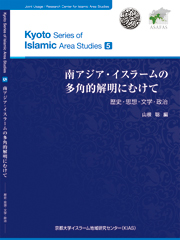
Towards Multilateral Elucidation of Islamic Trends in South Asia: History, Thought, Literature, and Politics
Edited by YAMANE So
(2010/November, vi + 131p.)
| Introduction (in Japanese) | (YAMANE So) | v | |||
| Part 1 | |||||
| I. | Commencement of Printing in the Muslim World: A View of Impact on Ulama at Early Phase of Islamic Moderate Trends | (Moinuddin Aqeel) | 2 | ||
| II | Religion, Fear and Terror: A Study of Muhammad Iqbal’s Religious Philosophy | (Zahid Munir Amir) | 18 | ||
| III | Ideological Perceptions of Pakistani Establishment and Cultural Acceptance of the Rebels in the Context of Urdu Literature | (Anwaar Ahmad & Qazi Abdul Rehman Abid) | 34 | ||
| Part 2 | |||||
| IV | Current Situation of Kashmir Issue (in Japanese) | (INOUE Aeka) | 48 | ||
| V | Pakistan's Situation under the War on Terrorism (in Japanese) | (YAMANE So) | 66 | ||
| Part 3 | |||||
| VI | Current Situation of Political Parties in Pakistan (in Japanese) | (MAMIYA Kensaku) | 98 | ||
| VII | Transformation of Political Power in post-Musharraf Regime (in Japanese) | (YAMANE So) | 122 |
Over 400 million Muslims, or approximately one third of all the world's Muslims, live in South Asia. This region, home to the world's largest Muslim population, has initiated many important political, intellectual and cultural developments within the Islamic world, and its people have played important roles in the global history of Islam. Moreover, in recent years, some serious international issues have manifested from the area neighboring Pakistan, a country that shares borders with India, China, the Middle East and Central Asia. In other words Pakistan has become an important factor in the stability of South and Central Asia and its geopolitical importance should not be overlooked. Neither a resolution to the Kashmir conflict nor lasting peace in Afghanistan will be possible without Pakistan playing a major role.
This booklet undertakes the preliminary task of clarifying some of the underlying influences that have shaped Pakistani society for the purpose of gaining an in-depth understanding of the South Asian scene and Islam in South Asia. The first half picks up cultural themes such as the evolution of the print media which facilitated the spread of moderate Islamic trends in South Asia; examines fear and terror reevaluated in the thoughts of a founding father of Pakistan, Muhammad Iqbal; and explores the cultural acceptance of the rebellion in the context of Urdu literature in Pakistan. The second half argues the political issues and contains historical notes on the Kashmir conflict and its enabling solution; detailed analysis of the extremist movements in Pakistan's North-West Frontier Province; a discussion of Pakistan's political instability in terms of the rise and decline of political parties, and a description of structural change and political process in post-Musharraf Pakistan. All of these perspectives will open the way for further multilateral elucidation of Islam in South Asia.


Best Practices in Socially Responsible Finance: Lessons for the Islamic Financial Industry from Leading Socially Responsible Financial Institutions in the UK
Salma Sairally
(2011年12月発行 vi + 70p.)
| Chapter One: INTRODUCTION | 1 | |
| Chapter Two: CSR AND THE GROWING SOCIALLY RESPONSIBLE FINANCE MOVEMENT | 4 | |
| Chapter Three: THEORETICAL FRAMEWORK FOR ASSESSING CORPORATE SOCIAL PERFORMANCE | 8 | |
| Chapter Four: TRANSLATING THE THEORETICAL CSP CONCEPTS INTO EMPIRICAL INVESTIGATIONS | 11 | |
| Chapter Five: RESEARCH METHODOLOGY | 15 | |
| A. Selection of the SRFIs | 16 | |
| B. Secondary Data Collection: Company Websites and Literature | 17 | |
| Chapter Six: EXAMINING THE SOCIAL RESPONSIBILITY OF SRFIs: THE UK EXPERIENCE | 19 | |
| A. Examining the CSR Principles Endorsed by the SRFIs in the UK | 19 | |
| B. Assessing the Management of CSR Issues by the SRFIs | 26 | |
| C. Evaluating the Corporate Social Responsiveness of the SRFIs | 32 | |
| D. Measuring the Outcomes of CSR Actions for the SRFIs | 35 | |
| Chapter Seven: SUMMARISING THE FINDINGS ON THE SOCIAL PERFORMANCE OF THE SRFIs | 40 | |
| Chapter Eight: LESSONS FOR THE ISLAMIC FINANCIAL SERVICES INDUSTRY FROM THE BEST PRACTICES OF THE SRFIs | 42 | |
| i. Highlighting the Islamic Ethical Values | 43 | |
| ii. Learning from the Screening Criteria of the SRFIs | 44 | |
| iii. Learning from the Engagement Practices of the SRI Funds | 44 | |
| iv. Establishment of Foundations for Carrying out Welfare Activities | 46 | |
| v. Innovative Products and Ideas | 46 | |
| vi. Establishing an Explicit System for Managing CSR | 47 | |
| vii. Measurement of Performance | 47 | |
| viii. Qualitative Screening Index to Rank IFIs according to their Social Performance | 49 | |
| ix. Transparency and Corporate Social Reporting | 50 | |
| x. Customer Participation | 51 | |
| Chapter Nine: CONCLUSION: INSTILLING AN ISLAMIC BANKING CULTURE | 52 | |
| Bibliography | 55 | |
| APPENDIX | 63 |
Abstract
Socially responsible finance (SRF), which endorses the principles of corporate social responsibility (CSR), has been increasingly used since the 1990s. Financial institutions like The Co-operative Bank and Friends Provident Stewardship Funds have emerged in the UK to meet customers' preferences of including ethical and environmental, social and governance (ESG) values in their investment and banking transactions. Similarly, a number of Islamic financial institutions (IFIs) have been established worldwide to offer Islamic financial products to Muslims who seek alternatives to the interest-based conventional financial system. These IFIs also highlight the relevance of the Islamic financial products to the larger society, especially the ethicallyconcerned. The drive of both financial movements is to bring ethics and social responsibility - whether rooted in secular humanism or in religious teachings - within the domain of finance. This serves as the underlying basis for building bridges between the two financial paradigms.
This study aims to examine the corporate social performance (CSP) of fourteen (14) leading socially responsible financial institutions (SRFIs) in the UK. The CSR practices of the SRFIs are evaluated through content analysis of their electronic materials on basis of their performance in four areas: (i) recognition and understanding of their CSR responsibilities; (ii) integration of corporate responsibility issues; (iii) management of CSR; and (iv) social performance in terms of commitment of resources towards CSR and the programmes set in place for the measurement and disclosure of CSR. The analysis revealed that a sophisticated understanding of CSR shaped the culture of the SRFIs which have mostly embedded CSR within their business transactions. CSR constituted an integral, explicit and strategic decision of management, with an appropriate management system in place and, in some cases, with indicators developed to assess CSR performance against planned targets. The best practices drawn from this study are believed to provide useful lessons to the Islamic financial services industry.

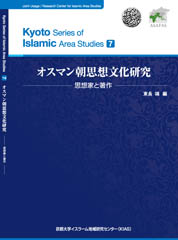
A Bio-bibliographical Introduction to the Intellectual History of the Ottoman Period (in Japanese)
Edited by TONAGA Yasushi
(2012/March, xiii + 162p.+xliv (Appendix) p.)
| Introduction | (TONAGA Yasushi) | ix | |||
| Explanatory Notes | xi | ||||
| Part I | Sufism, Tariqa Studies: References and Works | (TONAGA Yasushi, IMAMATSU Yasushi, Idiris Danismaz ) | 1 | ||
| Section 1 | Overview | 1 | |||
| Section 2 | Major Thinkers and Their Works | 24 | |||
| Part II | Theological / Logical Studies: Theology and Logic in Ottoman Period | (TAKESHITA Masataka) | 79 | ||
| Section 1 | Overview of Theological Studies | 79 | |||
| Section 2 | Major Thinkers and Their Works in Theology | 82 | |||
| Section 3 | Overview of Logic Studies | 89 | |||
| Section 4 | Major Thinkers and Their Works in Logic | 91 | |||
| Part III | Literary / Historical Studies: Possibility of Social Historical Studies using Ottoman Poetry | (HAYASHI Kayoko) | 95 | ||
| Section 1 | Overview | 95 | |||
| Section 2 | Major Thinkers and Their Works | 96 | |||
| Part IV | Studies of Political Thought: Siyasatnameh and History Book | (HAMADA Masami) | 125 | ||
| Section 1 | Overview | 125 | |||
| Section 2 | Major Thinkers and Their Works | 126 | |||
| Part V | Studies of Modern Thought: A Guide to Literature Research | (MISAWA Nobuo) | 143 | ||
| Section 1 | Overview | 143 | |||
| Section 2 | Overview of Logic Studies | 146 |
This booklet is intended as an introductory guide for students of the culture and thought of the Ottoman period. Although extensive knowledge has been accumulated of the historical studies in this era, comparatively little is known about the other intellectual fields. Consequently, as it may still be a little difficult to provide a general overview of each field, this booklet follows the style of an anthology with some useful additional information. Among the subjects covered in this booklet are the Classification of Science, Sufism and Tariqa, Philosophy and Science, Theology and Logic, Poetry, Political Thought, and Modern Thought.


South Asia and Islam:"Kagaya Hiroshi" Collection 1 (in Japanese)
Written by KAGAYA Hiroshi; Edited by YAMANE So, MATSUMURA Takamitsu, NIGO Toshiharu
(2013/March, viii + 527p.)
| Introduction | v | ||
| On Publication of “Kagaya Hiroshi” Collection | (YAMANE So) | vi | |
| Academic Achievements of Prof. Kagaya | (MATSUMURA Takamitsu) | viii | |
| Popular Islam and Sufism | 1 | ||
| Modern Islam | 165 |
KAGAYA Hiroshi, emeritus professor at Osaka University of foreign studies, is a pioneer of Islamic area studies in West and South Asia and has published prolifically. “The collection of Kagaya Hiroshi” (all three volumes) was awarded the fourth Prince Mikasa Academic Award of the society for Near Eastern Studies in Japan because of this large scientific contribution.


Islamic Finance for Agricultural Development in Malaysia
Muhammad Hakimi Bin Mohd Shafiai
(2013年11月発行 xi + 283p.)
| Foreword (Kosugi Yasushi) | vi | |
| Introduction | 1 | |
| Historical Background | 8 | |
| 1. Islamic Economics and the Islamic Revival | 8 | |
| 2. Islamic Economics and Capitalism | 10 | |
| 3. Islamic Economics as a System or a Science | 12 | |
| 4. Islamic Economics and the Moral Economy | 13 | |
| 5. Islamic Economics and Islamic Finance | 14 | |
| Chapter 1 Agriculture in Islamic Economics | 17 | |
| 1. Introduction | 17 | |
| 2. Agricultural Land Development in Islamic Economics | 21 | |
| 3. Some Selected Issues in Agriculture | 28 | |
| 4. The Significance of Islamic Economics and Islamic Finance in Agriculture | 31 | |
| 5. Conclusion | 38 | |
| Chapter 2 Islamization and Islamic Finance in Modern Malaysia | 40 | |
| 1. Introduction | 40 | |
| 2. The Role of Islam in the Development of Malaysia | 42 | |
| 3. A Theoretical Outline of Islamic Banking and Finance (IBF) | 52 | |
| 4. Islamic Banking and Finance in Malaysia | 67 | |
| 5. Conclusion | 79 | |
| Chapter 3 Agricultural Contracts in Islamic Jurisprudence (Fiqh): Al-Muzara’a And Al-Musaqa | 82 | |
| 1. Introduction | 82 | |
| 2. The Theory of al-Muzara’a Formulated in Classical Islamic Jurisprudence | 84 | |
| 3. Theory of al-Musaqa Formulated in Classical Islamic Jurisprudence | 89 | |
| 4. Comparison of al-Muzara’a and al-Musaqa | 91 | |
| 5. Legality of Al-Muzara’a and Al-Musaqa from Islamic Jurists’ Perspectives | 92 | |
| 6. “Agricultural Product and Loss Sharing” instead of “Profit and Loss Sharing” | 110 | |
| 7. Conclusion | 117 | |
| Chapter 4 Farmers’ Lives in Malaysia and Their Land Use Problems | 120 | |
| 1. Introduction | 120 | |
| 2. A General Overview of Agricultural Contracts among Farmers in Malaysia | 122 | |
| 3. A General Background of Idle Agricultural Land in Malaysia | 125 | |
| 4. The Methodology of Fieldwork in Malaysia, October-December 2010 | 129 | |
| A. Analysis of Farmers’ General Profiles | 134 | |
| B. Analysis of Credit Information | 144 | |
| C. Analysis of Landlord-Tenant Relationship | 146 | |
| 5. Some Issues to Ponder from the Fieldwork | 160 | |
| 6. Conclusion | 166 | |
| Chapter 5 Islamic Agricultural Finance and the Activation of Idle Agricultural Lands in Malaysia | 168 | |
| 1. Introduction | 168 | |
| 2. Agricultural Land Institutions in Malaysia for Activating Idle Agricultural Land | 170 | |
| 3. Proposed Islamic Financial Solution for Activating Idle Agricultural Land | 180 | |
| 4. The Roadmap of the “Agricultural Product and Loss Sharing” (aPLS) Scheme between Farmers, Agro Bank and the Department of Agriculture in Malaysia | 202 | |
| 5. Conclusion | 205 | |
| Chapter 6 Conclusion and Policy Recommendations | 208 | |
| 1. Conclusion | 208 | |
| 2. Recommendations | 220 | |
| Postscript | 225 | |
| Appendices | 227 | |
| Appendix I An English Glossary of Arabic Terms and Concepts Related to Islamic Banking | 227 | |
| Appendix II Malaysian Terminology | 241 | |
| Appendix III Malaysian Institutions and Financial Schemes | 242 | |
| Appendix IV Abbreviations Used in this Book | 244 | |
| Bibliography | 245 |
Excerpt from the Introduction
'Islamic economics' has its roots in the Islamic revival of the late nineteenth century, but the term was popularized during the 1940s. At that time, Islamic economic studies focused on the prohibition of interest (riba) and in the 1960s, the theoretical literature that shaped the Islamic banking and financial industry focussed on the principle of "Profit and Loss Sharing" (PLS) as an alternative to the interest based schemes of the conventional banking system.
Islamic banking began from the 1960s with Mit Ghamr (1963) in Egypt, and contemporary Islamic financial institutions emerged on the crest of the oil boom with funding from the oil-rich Gulf States. Beginning in the 1970s, several Islamic banks were established including: Dubai Islamic Bank in 1975, Faisal Islamic Bank of Sudan and Faisal Islamic Bank of Egypt in 1977, Jordan Islamic Bank for Finance and Investment and Islamic Banking System International Holdings, Luxembourg in 1978, Islamic Bank of Bahrain in 1979. Today, there are more than a hundred financial institutions operating partially or fully on an interest-free basis in Muslim and non- Muslim countries.
In recent years, Islamic banking and finance has focussed on trade, manufacturing, and other commercial transactions in urban areas, while the rural economy, especially the agricultural sector, has been neglected. The author of this book, in his search for sustainable economic solutions, sets out to address three important questions. ...

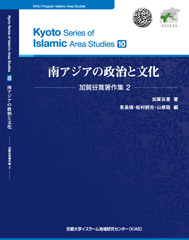
Politics and Culture in South Asia:"Kagaya Hiroshi" Collection 2 (in Japanese)
Written by KAGAYA Hiroshi; Edited by TONAGA Yasushi, MATSUMURA Takamitsu, YAMANE So
(2014/March, ix + 388p.)
| Introduction | (KOSUGI Yasushi, TONAGA Yasushi) | v | |
| Prof. Kagaya and Urdu Language and Literature | (MATSUMURA Takamitsu) | vi | |
| South Asia as an Islamic Area Study | (YAMANE So) | viii | |
| Pakistan | 1 | ||
| Book Reviews | 231 | ||
| Articles in English | 261 | ||
| Arab | 319 | ||
| Africa | 345 | ||
| Others | 363 |
KAGAYA Hiroshi, emeritus professor at Osaka University of foreign studies, is a pioneer of Islamic area studies in West and South Asia and has published prolifically. “The collection of Kagaya Hiroshi” (all three volumes) was awarded the fourth Prince Mikasa Academic Award of the society for Near Eastern Studies in Japan because of this large scientific contribution.

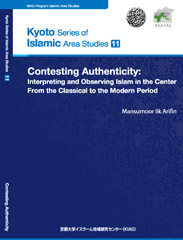
Contesting Authenticity: Interpreting and Observing Islam in the Center From the Classical to the Modern Period
Mansurnoor Iik Arifin
(2015/March, iv + 242p.)
| Acknowledgements | iv | |
| Introduction | 1 | |
| I- The Early Test and Challenges: Religio-Political Discourse and State-Building | ||
| 1. Background to the Egyptian Rebellion and its Role in the Murder of Caliph `Uthman | 5 | |
| 2. The Significance of the Murder of Wal.d II in Early Islamic History | 33 | |
| 3. Internal Structure and Ideological Basis of the `Abbasi Da`wa | 43 | |
| 4. Rallying Muslims against the Umawis: The Early Shi`is | 57 | |
| II- State and Society: The Center | ||
| 5. Bayt al-Hikma: A Melting Pot for Diverse Ideas and Socio-Religious Segments during the Heyday of Early Islam | 68 | |
| 6. Political Crisis and Muslim Bureaucrats in the Heyday of the Saljuqs: The Genesis of Sultan Malik Shah’s Power | 90 | |
| III- State and Society: New Center | ||
| 7. Religious Scholars and State: Patterns of Recruitment among the Ottoman Ulema | 114 | |
| 8. Major “Peripheries” of the Ottoman World: Learning Tradition in the Malay World with a Special Reference to Links and Networks | 130 | |
| IV- Non-State Actors in Endeavors to Live Islamically | ||
| 9. Islam, the Malay World and China: Links through the Spice Route in the Medieval Period | 141 | |
| 10. Shawkani and the ‘Closed Door of Ijtihad’: Did Shawkani Possess the Key to the Reopening of the ‘Closed Door of Ijtihad’? | 156 | |
| 11. `Ulama' in Changing Society: A Re-examination of the Deoband Movement | 165 | |
| 12. Articulating Religious Themes in a Mass Movement: The Khilafat Movement in Twentieth Century South Asia | 179 | |
| Postscript | 193 | |
| Selected Studies and Reference Work | 195 | |
| Index | 216 |
Excerpt from the Introduction
Islam provides its adherents with guidance, symbols, inspiration, and imagination. Despite the emphasis on spirituality and the eternal life, Islam also gives importance to the world and to history. The great and long-lasting achievements of the early Muslim generations are often referred to as proof of Islam's claim to truth.
The fact that Islam is a scriptural religion poses challenge and at the same time offers clear reference for its followers and the world. On the one hand, scripture emerges as a central institution in envisioning discourse, taking decisions and implementing action. On the other hand, scripture also becomes a source of contention about its meaning, significance and application.
The chapters in this book have primarily resulted from my long interest and research on Arabic and early Islamic discourse. Then my interest became more focused on the contest for authority in Islam for a very obvious reason: the Iranian revolution in the late 1970s. From discourse, I became more interested in examining the historical background of competition to ideological correctness resulting in the collection of materials on the opposition to authority as exemplified by the rebellion against 'Uthman and 'Ali, the two last khulafa' rashidun, various Sha'i protests, and internal dissent within the Umawi ruling class. More specifically, I sought further explanation for the brilliant achievement of the 'Abbasis in winning the support of diverse segments of the population from Iraq to Khurasan under the banner ofthe rule of 'an acceptable member of the House of the Prophet'.
Later, related to my further interest in the contemporary situation of human resources and education among the Muslim community, I have searched for factors for a Muslim response to modernization and more specifically the historical background in the great empire tradition of Muslim states. The history of the Ottomans was an inspiration and stimulation for me to look more closely at the role of education and the 'ulama' in the state and society at large. If the Ottomans succeeded in constructing a solid and long-lasting bureaucracy, among other things, through meticulous grading and promotion, including education and schooling, then I was also perplexed by the difficulties of Muslims under them and also those under the Mughals to adjust and respond when their empires were in decline and eventually defeated by the Western powers. Here I see major innovations shown by Muslim institutions, such as madrasa and 'ulama', which were autonomous. ...

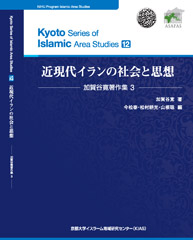
Society and Thought of Modern Iran:"Kagaya Hiroshi" Collection 3 (in Japanese)
Written by KAGAYA Hiroshi; Edited by IMAMATSU Yasushi, MATSUMURA Takamitsu, YAMANE So
(2015/March, vi + 506p.)
| Introduction | (IMAMATSU Yasushi, MATSUMURA Takamitsu, YAMANE So) | v | |
| Modern Iran | 1 | ||
| Book Reviews | 433 | ||
| Articles in English | 453 | ||
| Reports and Others | 485 | ||
| Postface | (KAGAYA Hiroshi) | 507 |
KAGAYA Hiroshi, emeritus professor at Osaka University of foreign studies, is a pioneer of Islamic area studies in West and South Asia and has published prolifically. “The collection of Kagaya Hiroshi” (all three volumes) was awarded the fourth Prince Mikasa Academic Award of the society for Near Eastern Studies in Japan because of this large scientific contribution.


































